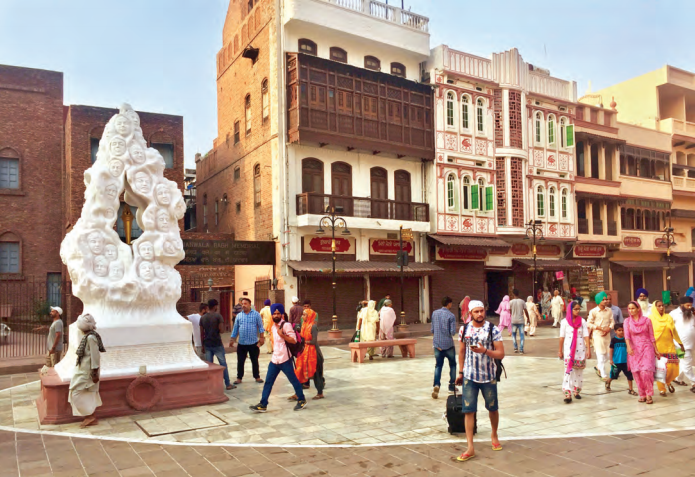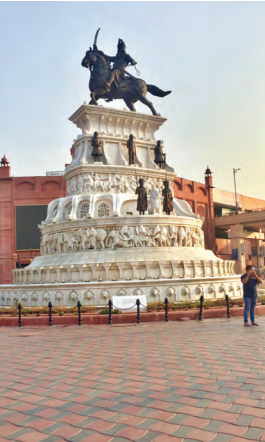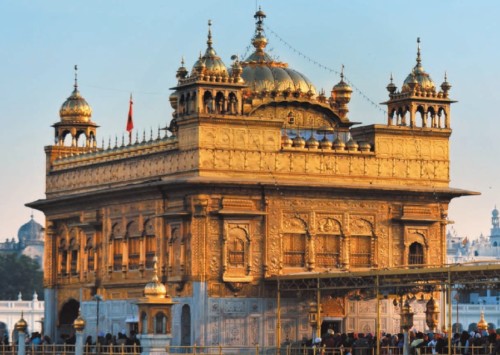Amritsar’s New Avatar
India & You
September-October 2018

The Golden City is brimming with new attractions that give you a peek into its rich culture and history. From museums and farm-stays to a fort and grand heritage street – it’s time to explore this city beyond the Golden Temple and the Wagah Border.
What can I tell you about Amritsar – the biggest city of the north Indian state of Punjab – that has not been said before? Actually, aplenty. On my first visit there, three years ago, the iconic Golden Temple and the city’s famous food had me enthralled. However, on a recent trip, a host of new attractions that have come up brought me even closer to this city.

Statue of Maharaja Ranjit Singh, the leader of the Sikh empire
Walking down the heritage corridor
While the gleaming Sri Harmandir Sahib, popularly known as the Golden Temple, is the heart of this over 450-year-old city and is on every visitor’s itinerary, more recently the path leading to Sikhism’s holiest shrine has received a dramatic makeover and has turned into a tourist attraction in its own right. Called the Heritage Street, it was opened in October 2016 and at its every turn gives a glimpse into the history and culture of Punjab.
Starting at the 150-year old Town Hall, the one-kilometre stretch up to the Golden Temple is dressed up with statues, tiled pathways and bright lights at night.
A tall statue of Maharaja Ranjit Singh, the leader of the Sikh empire, riding a horse with a sword in his hand perched on a marble pedestal with carvings of elephants, Sikh generals and war scenes is at Chowk Phowara. A massive screen, just behind the statue, where one can watch the holy book being read inside the Golden Temple is also part of the new corridor.
The biggest surprise for me, however, was when I approached the Golden Temple. Instead of a grimy, crowded road, where hawkers and rickshaw pullers were jostling for space on my last visit, this time I was walking down a broad, neatly tiled pathway on a pedestrian-only zone, with shops on either sides done up attractively in pink Kota stone tiles. Of course there are still hawkers selling wares that many tourists want, such as colourful jootis (traditional shoes) and religious artefacts but now the entire look is reminiscent of a plaza in a European city. Just after the entrance of this street, there’s a sculpture depicting Sikhs dancing their famous bhangra and it seems quite appropriate. After all, this iconic folk dance that features in virtually all north Indian weddings and even Bollywood films is central to Punjabi culture.
A little ahead I come face-to-face with a beautiful marble sculpture outside Jallianwala Bagh. Called Smriti, it has many heads that together form a flame. It is dedicated to the people who lost their lives when a British general opened fire in 1919 on a gathering of Indians in the walled garden that is Jallianwala Bagh. Walking further, I reach the huge marble plaza, which is the entrance of the iconic Golden Temple.
Learning more at the Partition Museum
The older generation often recalls stories of the partition of India into two separate nations in 1947 and the event is recorded in history books but until the Partition Museum opened in Amritsar last year, there was no specific museum about that traumatic episode. Located in a red brick building in the east wing of the Town Hall, it brings you closer to the real-life stories of how people in both countries (India and Pakistan) were affected when millions of people had to cross the newly carved borders amid bloodshed and violence.
The Partition Museum moved me and I end up spending hours browsing through its 14 galleries. Set up by the Arts and Culture Heritage Trust, the highlights are the personal items donated by people who had to cross the border, each with its own poignant story. For example a carefully-preserved phulkari (embroidery from Punjab) jacket and briefcase tells the story of a woman and a man who were separated in those troubled times, then luckily reunited at a refugee camp. A radio used by a man while he was crossing the border to escape the mobs on both sides demonstrates how difficult the journey was. Newspaper clippings, letters, paintings and photos give more insights.
Mallika Ahluwalia, CEO of the Partition Museum tells me that the initiative was born because: “We felt that it was very important that the stories of our own families and millions like ours should have a physical space that remembers, commemorates and pays a tribute to everything that those people went through.” A well in the museum pays tribute to the countless women who used to jump inside them to escape violent mobs. The last gallery called the Gallery of Hope has a gigantic tree where people can write messages on green paper leaves.
Exploring the Gobindgarh Fort
Under the control of the Indian Army until it was handed over to the Punjab government in 2008, few had stepped inside this fort until it was thrown open to the public last February after restoration work. Every evening a dramatic sound and light show, which uses technology like laser lights, animation and projection mapping, brings alive the history of Punjab at Gobindgarh and is truly awe inspiring. Originally built as a mud fort by Gujjar Singh Bhangi, the local chief in the 1760s, it was rebuilt in the 19th century by Maharaja Ranjit Singh.
It is at this fort that the famous Kohinoor diamond was kept until it was taken by the British and gifted to Prince Albert in 1950. Now the diamond is at the Tower of London in the United Kingdom. A key attraction here is the replica of the canon called zamzama or ‘taker of strongholds’ that was used in important battles. Other attractions here include a 7D show, exhibitions, a museum and performances of traditional Punjabi dances.
Enjoying local culture at Sadda Pind
One can get an authentic flavour of Punjabi culture at Sada Pind, a heritage village near Amritsar. Literally translated this place means our village and visitors can get an entire range of rural experience here – from traditional cuisine to handicrafts and from music and dance to textiles, all in a lovely, rustic setting. There are houses dedicated to different activities. The musician’s house is where one can hear folk songs; a haveli (mansion) gives insight into how village landlords lived; and a potter’s house is where you can try your hands at the age-old craft of pottery.
Hop-On-Hop-Off bus
There’s nothing like the ease and convenience of sightseeing by using a HopOn-Hop-Off bus. Though many cities in India are still to adopt this, Amritsar has done it. So sit back, enjoy and listen to the commentary as the bus takes you around 17 spots across the city. The cost of the ticket is INR 250 (EUR 3) and the timings are 8:00 am to 8:00 pm. You can get off and on at any bus stop mentioned in the ticket handed to you.
Staying at farm-stays
Lush farms producing some of India’s best varieties of wheat and rice, fields swaying with golden mustard crops are central to the life of this rich farming state, so a visit to Punjab is not complete without a farm experience. Now many places around Amritsar offer a stay in the vicinity of fields where you can eat local food, take a tonga (horse cart) ride to villages close by, visit a dairy farm and enjoy Punjab in its true rustic setting.
Windsong is a charming bed and breakfast located next to gorgeous yellow mustard fields. The six rooms here are named after rivers in Punjab. Don’t miss the food tour organised for guests – they take you to little-known local haunts that are not on the popular food trail. Punjabiyat is another place about one hour away from the city with four cottages where one can get a slice of Punjabi culture and disconnect from the urban experience of Amritsar. Another lovely place is The Kothi in Gurdaspur, where you can wake up in the morning to milk cows, weave a basket or learn the art of making a traditional Punjabi dish.

Above: The savoury Amritsari kulcha and chole (crisp bread and chickpeas); Below: The sweet gulab jamun
Punjab State War Heroes Memorial-cum-Museum
In a state with a long martial tradition, this museum is a tribute to all the soldiers of Punjab who fought at various wars and lost their lives. A gigantic sword with four lion heads at the base grabs your attention the moment you see the memorial, which is dedicated to the martyrs. The names of 3,500 martyrs are inscribed on it. There are eight galleries depicting different war periods.
Food trail
While there are many new things to explore, some things never change and one of them is the legendary joints where you sample the rich, decadent food of this city, which is the culinary heart of Punjab. There is the thali (assortment of dishes) at Kesar da Dhaba, the melt-in-the-mouth tandoori (grilled) chicken at Beera Chicken Corner, puri chole (fried fluffy bread with chickpea gravy) at Kahna Sweets, and gulab jamun (deep fried sweet dish dunked in sugar syrup) at Sharma Sweet Shop. Although Amritsar was for long a quick weekend halt for many visitors, with so many new things on the plate for tourists, two days may no longer be sufficient to do justice to this city.
How to Reach
Sri Guru Ram Dass Jee International Airport in Amritsar has daily flights to major Indian cities and to a few international destinations. Amritsar railway station has daily trains to many cities and towns across India.
Where to Stay
Windsong is a charming bed and breakfast with sprawling rooms, a garden and swimming pool. It is run by the Sehgal family who also conduct food tours and make you experience Amritsari food.










